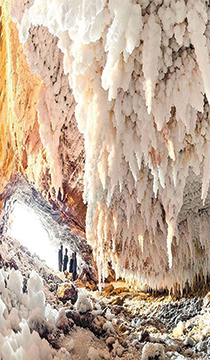Namakdan Salt Cave
One of the most attractive natural landmarks, that has 6.5 km labyrinth of cave system and located on Gheshm Island in the Persian Gulf called Namakdan Salt Cave. In persian, the word "namak" means salt or Sodium Chloride, as ordinary kitchen salt is known among chemists and it is salt or namak that Namakdan Mountain on Qeshm Island is made of it. Salt Cave is 340 meters and a base diameter of about 7Km. This salty cave is the longest salt cave in the world. From outside to the inside of this cone shaped mountain, there are crystalline salt all over it. You can only visit the first 50 or so meters but it’s well worth the trip to see this Geo wonder. Inside the cave, especially when you go deep in it, it's really dark and you have to take a flashlight with yourself to see where you are going. These salts of this cave have such a combination such as magnesium and because of this reason it can be used as a medical salt, especially for pro athletes.

Description
The Saltwater flows that move on the bed of salty cave creates an remarkably fascinating landscape for the visitors. The saltwater flows reflect the images around it and add up to the handsomeness of the cave. There is a small natural white spring that is fed by the saltwater flows. This spring flows during the year. The wetness of the island together with the entrance of water into the cave cause the saturated saltwater to leak and produce attractive icicles on the ceiling. Magical stalactites and stalagmites, also salt crystals (such as needle-shaped, round, or multi-facet) formed by sedimentation of salt, are visible from the first twist of the cave, which step by step increase as one moves toward the end of the cave. From the halfway to the end of the cave, salt crystals carpet the floor, forming salt streams which offer a splendid view to the visitors.
The result of natural activities caused enormous salt masses moved toward the surface of the earth in Namakdan Salt Cave and then due to their lighter weight in comparability with the weight of their surrounding structures and then jog out of the openings or weak points on the surface of the earth as salt domes.
According to the excavations made, this salt cave number 3 is now registered as the longest salt cave in the world with a length of 6400 meters and 570 million years of age, dating back to the Cambrian era. General shape of the cave is a curved bow and its entrance wall is covered by colorful strips of salt and different layers of minerals such as hematite and oligist. In addition, in some areas where water has found its way to the ground, some beautiful ponds have been formed with salt crystals.
Qeshm Island Geopark
In 2006 the 300-sq-km mountainous area on the western half of Qeshm Island was selected as the Qeshm Island Geopark, Iran’s first member of the Unesco-listed Global Geopark Network (to be a member, parks must have a geological heritage of international significance and must use that heritage to promote the sustainable development of the local communities who live there). When you travel this area or looking at it on a Google Earth image, the geological importance is easy to see. Nature has carved steep-sided stone canyons, eroded flat-topped hills into sandy dunes and impressive organ-pipe ridge lines, and dug deep into the island to form caves including Khare Namaki. The park is managed by a small but extremely motivated group that works with the Qeshm Free Zone Organization, Unesco, NGOs, ecotourism operators, Iranian naturalists and the local community to preserve the island’s unique geology and heritage.
Location of Namakdan Salt Cave
Distance of salt cave from the city of Qeshm is 90 kilometers and is on the southwestern part of the island. If you are interested in nature, you can walk this distance to get to the cave. There is not much light when you enter the cave and it gets darker as you walk forward to the depth of the cave. Therefore, do not forget to take flashlights with you. Please also note that you need an expert guide or else you will get lost.